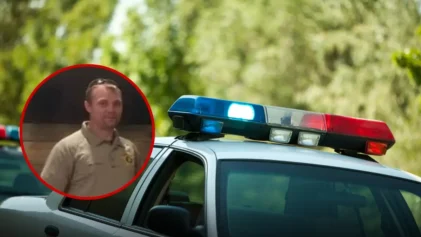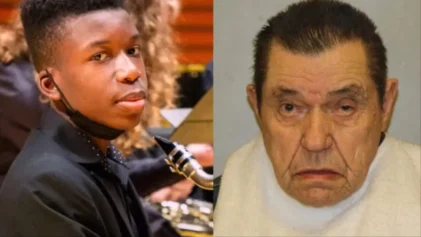The white Oregon man charged in the slaying of Aidan Ellison claims he shot the 19-year-old Black teen in the chest in self-defense after Ellison punched him in the face repeatedly.
That’s according to newly revealed information from a probable cause affidavit obtained by Atlanta Black Star.

Yet the affidavit contradicts that claim. It suggests neither Ellison nor Robert Paul Keegan, the 47-year-old man charged with killing him, showed any injuries indicative of a physical altercation. The autopsy report cited in the affidavit showed no signs of injuries to Ellison’s hands consistent with a fight. And the homicide detective who filed charges against Keegan said he had no visible signs of injury to his face.
The affidavit charged that Keegan “showed reckless and extreme indifference to the value of human life” by shooting Ellison in the chest during the Nov. 23 confrontation over loud music in the parking lot of the Stratford Inn motel in Ashland, Oregon.
According to the Ashland Police Department, both men were staying at the motel but didn’t know each other. Authorities said Keegan was irked that Ellison was playing music loudly outside his motel room around 4 a.m. and asked the teen to turn it down. Ellison refused and Keegan pulled a gun from his coat at some point during the encounter as the two were arguing.
But Keegan claims Ellison “struck him in the face several times with his left fist.” He told Ashland Police Sgt. Bon Stewart, the detective that investigated the case, that he backed away after the alleged attack, drew his gun, “racked a round” into the chamber and shot Ellison in the chest because “he was in fear for his personal safety,” according to the court documents.
The affidavit also indicates Keegan shot Ellison in front of a motel worker he’d fetched just minutes before the shooting.
Jackson County Circuit Judge Lorenzo A. Mejia, who is presiding over Keegan’s case, unsealed the affidavit following a public records request from The Oregonian, the newspaper reported on Monday.
The one-page documents mentions findings from the autopsy report, which seem to dispute Keegan’s claim. Medical examiners found no injuries to Ellison’s hands “indicative of him punching Keegan,” the report stated. There were also no visible signs of injury to Keegan’s face, according to Stewart.
The charging document also revealed more details about the timeline that led up to the fatal shooting. According to the affidavit, Keegan first asked Ellison to turn down the loud music about 4 a.m. shortly after he was awakened by the noise. When the teen refused, Keegan got dressed and went to a motel reception area and complained to Angel Carlin, the front desk clerk. As Keegan was dressing, he armed himself with a 9mm Mossberg handgun.
The shooting didn’t happen until 4:33 a.m., sometime after Carlin went out to the parking lot to talk to Ellison. Keegan interrupted that conversation and confronted Ellison a second time, according to the document. An argument ensued, and Keegan said he pulled his gun from his jacket and fired at Ellison’s chest as Carlin was standing “near and next” to the teen, according to the affidavit.
The bullet pierced Ellison’s heart and lungs. He died at the scene.
The document indicates Keegan illegally concealed the gun in his coat jacket before taking aim at Ellison.
Keegan was charged with second-degree murder, first-degree manslaughter, reckless endangering and unlawful carrying of a firearm in connection with the deadly ordeal. He pleaded not guilty to all charges during a Nov. 27 arraignment but remained jailed with no bond set Tuesday.
The shooting occurred less than a mile from the campus of Southern Oregon University in downtown Ashland. Linda Schott, the university’s president, issued a statement Tuesday, urging community leaders to create a safer and more welcoming environment for people of color.
“This incident was an indisputable tragedy, another example of a disagreement that could have been resolved peacefully, but instead it ended in violence, and another example of a black man killed by a white man,” Schott wrote. “Although Aidan was not an SOU student, he was a member of the larger Ashland community, and his death must make us stop and ask what else we can do to prevent such violence in the future.”
Activists from the Southern Oregon Black Leaders, Activists, and Community Coalition are planning a candlelight vigil 2 p.m. Wednesday, Dec. 2, at the Medford City Municipal Courthouse. The group will also be hosting a community meeting Dec. 7 to develop policy initiatives for southern Oregon’s Black community.
By Tuesday, a GoFundMe set up in Ellison’s name had raised over $20,000. His killing has been compared to the murder of Jordan Davis, a 17-year-old Black teenager shot by a white man during a dispute over loud music in the parking lot of a Jacksonville, Florida, gas station in 2012.
Michael Dunn, 53, was convicted of first-degree murder for killing Davis, the son of Lucy McBath, who went on to be elected to the U.S. House of Representatives from Georgia’s 6th District in 2018. A judge sentenced Dunn to life in prison without parole.
Oregon is regarded as a super-liberal state in the Pacific Northwest. But SOBLACC spokeswoman Precious Edmonds noted that Black people make up little more than 2 percent of the state’s population and even less of the demographic in cities like Ashland, as reflected by U.S. Census numbers. She called Ellison’s death a “casualty of white supremacy.”
Oregon Humanities, a state-sanctioned nonprofit research organization, documented southern Oregon’s sordid racial history in a 2016 trip down memory lane. Jackson County had an active Ku Klux Klan faction leading up to World War II. And cities like Ashland were widely known as “sundown towns,” unwelcome to Black citizens after dark.
“Oregon has a history, and that culture is still perpetuating to this day,” she told Atlanta Black Star on Tuesday. “A lot of the people who live here, they can go through their day without even interacting with a Black person. Or not even just a Black person, another person of color. And so they’re not familiar with with Black people.”
Police have made no indications that Ellison’s shooting was racially motivated. But Edmonds contends it had less to do with loud music and was more of an outgrowth of white supremacy.
“He [Keegan] was uncomfortable with the level of the music,” she explained. “So he felt the need to confront this person. And then when he found the young boy, he was Black, he was younger than him. And so I feel like he assumed that when he confronted him, that he would comply. That what white supremacy will require is that Black bodies should comply to the needs and the wants and desires of white people. And it sounds like that didn’t happen, or he [Ellison] didn’t immediately agree with him. So he shot him. I feel like that’s what happened and white supremacy made that possible.”


